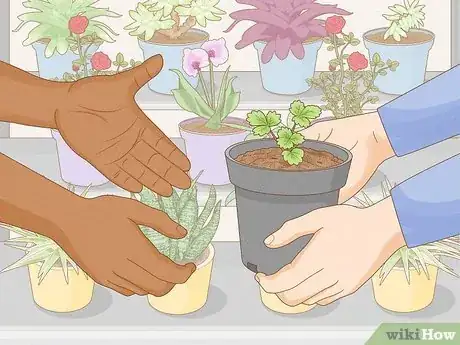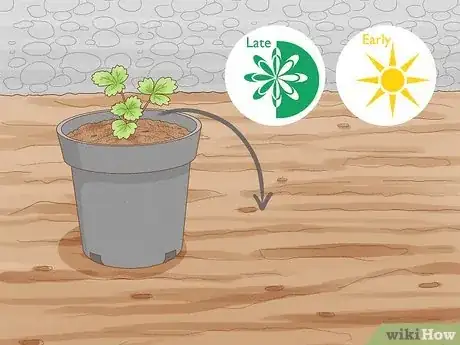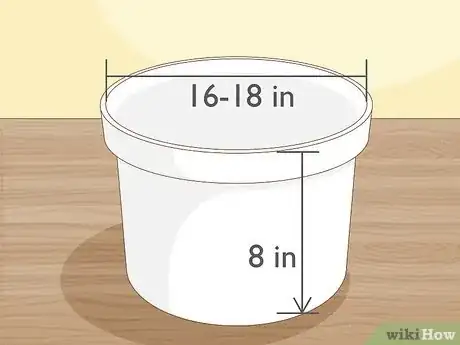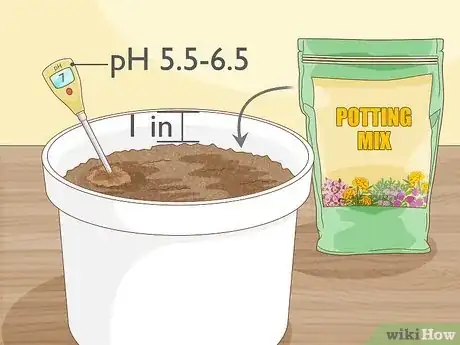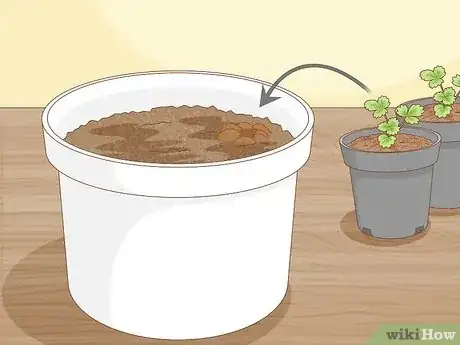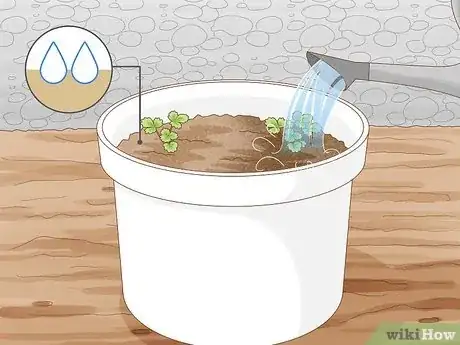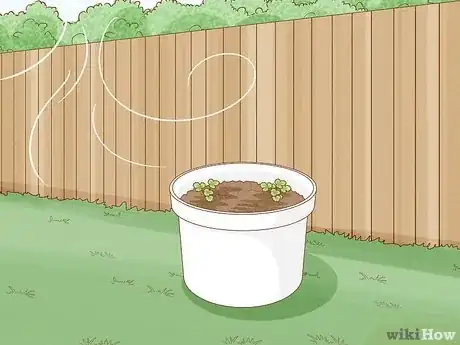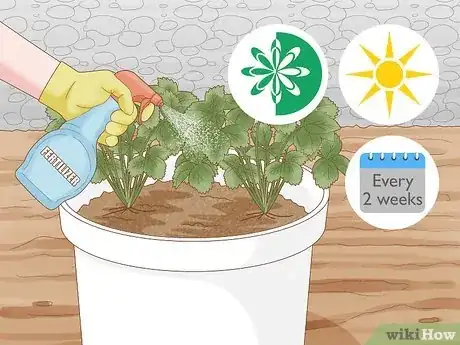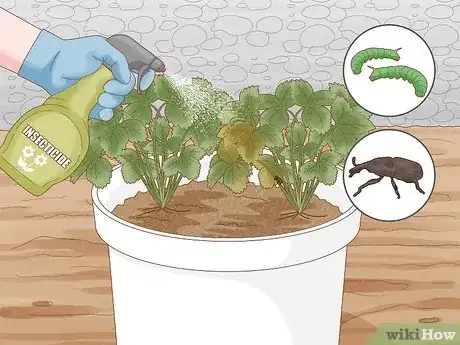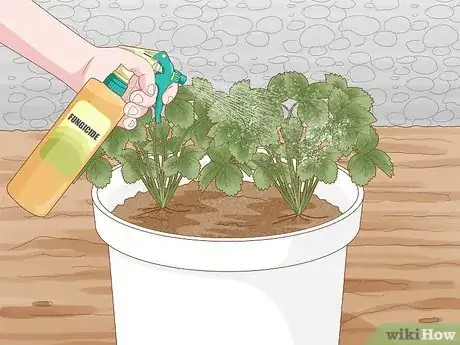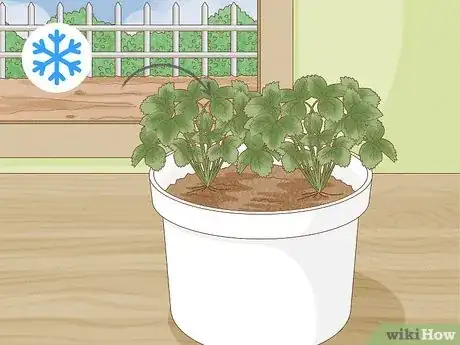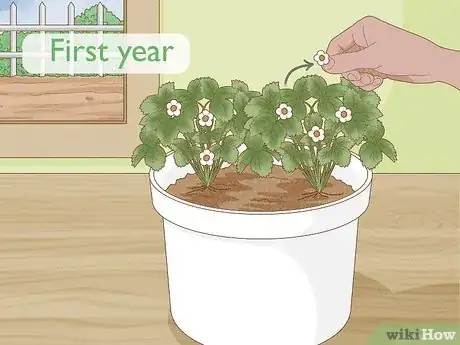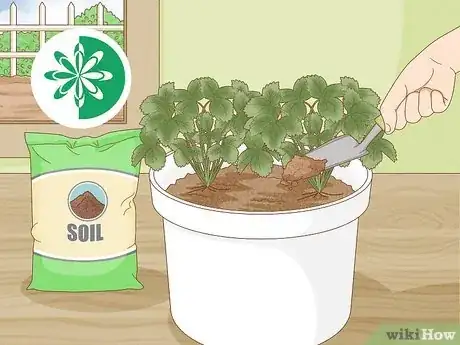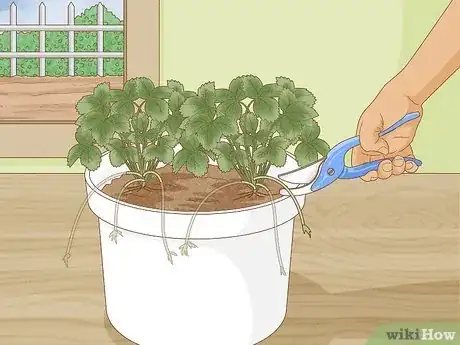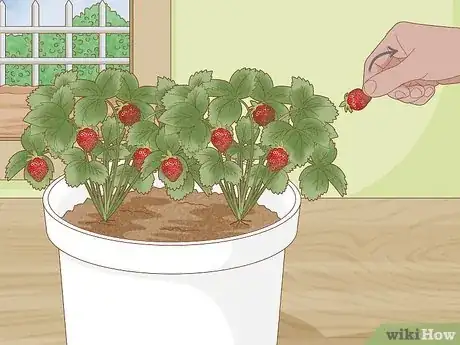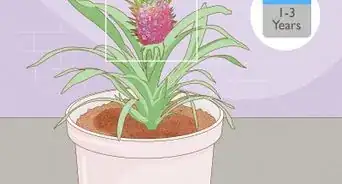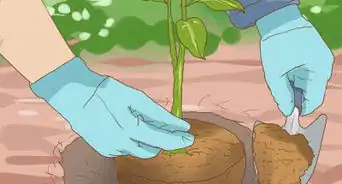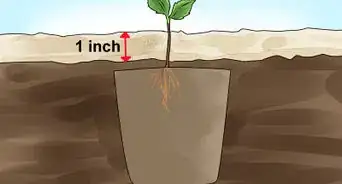This article was co-authored by Maggie Moran. Maggie Moran is a Professional Gardener in Pennsylvania.
There are 15 references cited in this article, which can be found at the bottom of the page.
wikiHow marks an article as reader-approved once it receives enough positive feedback. This article has 15 testimonials from our readers, earning it our reader-approved status.
This article has been viewed 364,564 times.
Strawberries are easy to grow in pots, thanks to their shallow roots. These plants simply require a wide, shallow pot, rich soil, and plenty of sunlight. Make sure to watch the plant carefully for signs of pests, fungus, and rot. If you want to harvest the berries, prune runners and flowers carefully to produce a larger, tastier bounty.
Steps
Planting the Strawberries
-
1Buy a starter plant or runner from a nursery. Strawberries are rarely grown from seed in home environments. Typically, you will grow strawberries from a small starter plant or from a cutting from another strawberry plant, known as a runner. Both can be easily transplanted into pots using the same methods.[1]
- Runners are often cheaper than starter plants, but some may require special care, such as soaking or refrigeration. Follow the instructions from your nursery if this is the case.
- Day-neutral plants (which produce multiple small harvests) or everbearing plants (which produce 2 harvests a year) are ideal for growing in containers. While June-bearing plants can be grown, they will only produce 1 large harvest a year and often do better when grown in a garden.[2]
-
2Start growing the strawberries in late spring or early summer. Get your starter plant or runner right before you plan to plant it. With some varieties, you may be able to get a harvest by fall.[3]
- Runners can usually be kept in the fridge for a few days before planting while starter plants can survive in their pots from the nursery. Don't wait more than a few days to plant, however.
- Plant your strawberries after the last frost. Check growing almanacs for the last expected frost date in your area.
Advertisement -
3Get a pot that is 16–18 inches (41–46 cm) wide and 8 inches (20 cm) deep. Make sure there are holes on the bottom so that water can drain from the pot. Terracotta pots, growing beds, window boxes, and hanging boxes may all work.[4]
- If you decide to use a hanging box, it is important to make sure that the plant does not dry out easily. Keep the pot away from windy areas and feel the soil often to see if it is dry.
-
4Fill the pot with potting mix or compost. Use a premixed potting soil with a pH between 5.5 and 6.5 or simply use compost. Fill the pot up to about 1 inch (2.5 cm) below the top.[5]
- For large and heavy pots, load the bottom of the pot with small rocks or ceramic pieces. Place landscaping fabric on top before filling with soil. This will help the container drain. It will also make the pot lighter than it would be if it was completely filled with soil, helping you move it if needed.[6]
- Don’t use soil from your backyard. It may not drain as easily, and it may not be the ideal pH for a strawberry plant.
-
5Transplant the strawberries into the pot. Dig a hole that is deep enough for your strawberry’s roots. You can use its current nursery pot as a guide. Remove the strawberries from the pot and place them within the hole. Push dirt back over the roots to cover them. Water the soil around the strawberries.[7]
- The green, thickened stem (called the crown) should sit just above the surface of the soil while the top of the roots should sit just below the surface.
-
6Space separate plants about 10–12 inches (25–30 cm) apart. If you have a large container, you can grow more than 1 strawberry plant in it. Spacing out the plants gives each plant enough room to grow.[8]
Caring for Strawberry Plants
-
1Give the strawberries about 6-10 hours of sunlight a day. It is best to set the pots outdoors during spring, summer, and fall so that they can get the most sunlight. If this is not possible, try keeping them by a very sunny window.[9]
- If there is not much sunlight in your region or if you can’t keep them in direct sunlight, set up a grow-light in your home. Place the strawberries plants under it for 6-10 hours a day.
- Remember to rotate the container every week. This will help each side of the plant get enough sunlight.
-
2Water the plant whenever the soil gets dry. Once a day, test the soil with your finger by sticking it into the soil up to the first knuckle. If it feels dry and doesn’t clump, water the strawberry plant. Make sure to water near the bottom of the plant. Watering the leaves could encourage fungus to grow.[10]
- It is better to water a little bit more often than it is to water the plant too much at one time. If standing water remains in the pot after you’ve watered, cut back on how much water you give the plants.
-
3Protect the pots from windy conditions. Wind can dry out the soil and knock the pots over, damaging your strawberries. If it gets windy where you live, keep the pots against a fence, deck, or shed. Alternatively, place stakes around the pot to keep it in place.[11]
-
4Give the plant liquid fertilizer every 2 weeks in the spring and summer. Potted strawberries often require fertilizer because they cannot get nutrients as easily from the soil. Use a 10-10-10 fertilizer or use a special mix, such as a liquid tomato feed. Follow the instructions on the label for fertilizing your plant.[12]
-
5Use insecticides to kill pests. If you notice holes on your leaves, discolored leaves, or nibbled berries, you may have pests eating on your berries. Insecticidal soaps or products containing neem are effective against caterpillars, thrips, and beetles. Follow the instructions on the label before using.[13]
- For most pesticides, spray it directly onto the leaves, either in the early morning or evening.
- If birds are eating your berries, drape a net or mesh over the plant to keep them away.
-
6Kill fungus with a fungicide. Strawberries can easily develop fungus. You may notice powdery spots or discoloration on the leaves, get a fungicide from a garden store or nursery. Make sure it is labeled as safe for strawberries. Follow the instructions on the label to use.[14]
- Keep potted strawberries away from tomatoes, potatoes, and eggplants, as these are common carriers of fungus that can spread to strawberries.
- Watering the base of the plant and not the leaves can help prevent fungus from growing.
- Remove any leaves with fungus to prevent it from spreading to other parts of the plant.
-
7Move the strawberry plants indoors in the winter. If you kept your strawberries outdoors, make sure to bring them in before the first frost. Check your local weather service to see when the first frost typically occurs in your area.[15]
- Place the containers near a sunny window or put them under a grow light for the winter. This will ensure that they get enough sun during this time.
- Keep the containers in an unheated garage, basement, or room. You only need to water the plant once every 1-2 weeks.
Encouraging a Harvest
-
1Remove the flowers that appear in the first year. Pluck or cut these flowers off to skip the first harvest and produce a stronger second harvest. If you have a day-neutral or everbearing variety, remove flowers until the end of June to get a harvest in the fall. If you have a June-bearing variety, remove all flowers in the first year.[16]
-
2Add new soil or compost to the pot in spring. Since pots can’t get nutrients from the ground, it is important to replenish the soil in the pot each year. March or April are good months to do this.[17]
- If you’re using small containers, like window boxes or hanging baskets, replace the soil entirely. Remove the strawberry gently from the pot, being careful not to disturb the roots. Discard any remaining soil and replace it with fresh potting soil.
- If you’re using a large growing bed or pot, just mix fresh compost into the top layer of soil in the pot. You do not need to replace all of the soil.
-
3Get rid of runners unless you want to grow new strawberry plants. Your strawberry plant will put out long, leafless vines. Seedlings and roots will grow from these runners for new plants, but they will also divert energy away from berry production. Cut these runners off with a pair of gardening shears.[18]
- If you want to grow new strawberry plants, keep the runners. Pin the small plantlet on the stalk into the soil using a hairpin or a piece of wire. Once it sprouts leaves, cut it free from the mother plant and move it to a separate container.
-
4Harvest the strawberries when they turn mostly red. Harvest all strawberries once they ripen, and don’t leave any rotting berries on the bush. To pick the berries, simply twist the stem off the plant. Wash the strawberries before eating.[19]
Expert Q&A
-
QuestionCan you grow strawberry plants indoors?
 Maggie MoranMaggie Moran is a Professional Gardener in Pennsylvania.
Maggie MoranMaggie Moran is a Professional Gardener in Pennsylvania.
Home & Garden Specialist Yes, you can grow them indoors. Make sure to provide the proper soil and lighting.
Yes, you can grow them indoors. Make sure to provide the proper soil and lighting. -
QuestionWhat else can be grown in a strawberry pot?
 Maggie MoranMaggie Moran is a Professional Gardener in Pennsylvania.
Maggie MoranMaggie Moran is a Professional Gardener in Pennsylvania.
Home & Garden Specialist Some of the best plants for a strawberry pot are basil, cacti, and some succulents, among many others.
Some of the best plants for a strawberry pot are basil, cacti, and some succulents, among many others. -
QuestionDo strawberries need a lot of sun?
 Maggie MoranMaggie Moran is a Professional Gardener in Pennsylvania.
Maggie MoranMaggie Moran is a Professional Gardener in Pennsylvania.
Home & Garden Specialist They require an average of 6 hours of sun each day, although they won't do well in full shade either.
They require an average of 6 hours of sun each day, although they won't do well in full shade either.
Things You’ll Need
- Starter plants or runners
- Planting pot or hanging basket
- Potting soil or compost
- Fertilizer
- Trowel
- Garden shears
- Watering can or hose
- Insecticidal soap or neem
- Fungicide
- Grow lights (optional)
References
- ↑ https://www.almanac.com/plant/strawberries
- ↑ https://www.bhg.com/gardening/container/plans-ideas/berries-in-containers/
- ↑ https://www.almanac.com/plant/strawberries
- ↑ https://garden.org/learn/articles/view/4058/
- ↑ https://www.growveg.com/guides/how-to-grow-strawberries-successfully-in-containers/
- ↑ https://garden.org/learn/articles/view/4058/
- ↑ https://www.growveg.com/guides/how-to-grow-strawberries-successfully-in-containers
- ↑ https://www.growveg.com/guides/how-to-grow-strawberries-successfully-in-containers/
- ↑ https://extension.umaine.edu/publications/2067e/
- ↑ https://www.bhg.com/gardening/container/plans-ideas/berries-in-containers/
- ↑ https://garden.org/learn/articles/view/4058
- ↑ https://www.rhs.org.uk/advice/grow-your-own/fruit/strawberries
- ↑ http://edis.ifas.ufl.edu/hs403
- ↑ http://edis.ifas.ufl.edu/hs403
- ↑ https://garden.org/learn/articles/view/4058
- ↑ https://extension.illinois.edu/strawberries/growing.cfm
- ↑ https://garden.org/learn/articles/view/4058
- ↑ https://www.growveg.com/guides/how-to-grow-strawberries-successfully-in-containers/
- ↑ http://edis.ifas.ufl.edu/hs403
About This Article
To grow strawberries in a pot, start by purchasing a starter plant or a runner from a nursery, along with a pot that’s 16 to 18 inches wide and 8 inches deep. Next, fill the pot with premixed potting soil or compost, transplant the strawberry plant into the pot, and water the soil. Give your plant 6 to 10 hours of sunlight a day and water it whenever the soil is dry. Then, fertilize it with a 10-10-10 mix every 2 weeks, and spray it with insecticide and fungicide to kill pests and fungus if you see discoloration on the leaves. For more tips from our Horticultural reviewer, like how to harvest strawberries, read on!
